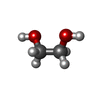Entry Database : PDB / ID : 9fqsTitle EGFR Exon20 insertion mutant NPG bound with Compound 39 Epidermal growth factor receptor Keywords / / Function / homology Function Domain/homology Component
/ / / / / / / / / / / / / / / / / / / / / / / / / / / / / / / / / / / / / / / / / / / / / / / / / / / / / / / / / / / / / / / / / / / / / / / / / / / / / / / / / / / / / / / / / / / / / / / / / / / / / / / / / / / / / / / / / / / / / / / / / / / / / / / / / / / / / / / / / / / / / Biological species Homo sapiens (human)Method / / / Resolution : 1.783 Å Authors Hilbert, B.J. / Brooijmans, N. / Milgram, B.C. / Pagliarini, R.A. Funding support 1items Organization Grant number Country Not funded
Journal : J.Med.Chem. / Year : 2025Title : Discovery of STX-721, a Covalent, Potent, and Highly Mutant-Selective EGFR/HER2 Exon20 Insertion Inhibitor for the Treatment of Non-Small Cell Lung Cancer.Authors: Milgram, B.C. / Borrelli, D.R. / Brooijmans, N. / Henderson, J.A. / Hilbert, B.J. / Huff, M.R. / Ito, T. / Jackson, E.L. / Jonsson, P. / Ladd, B. / O'Hearn, E.L. / Pagliarini, R.A. / ... Authors : Milgram, B.C. / Borrelli, D.R. / Brooijmans, N. / Henderson, J.A. / Hilbert, B.J. / Huff, M.R. / Ito, T. / Jackson, E.L. / Jonsson, P. / Ladd, B. / O'Hearn, E.L. / Pagliarini, R.A. / Roberts, S.A. / Ronseaux, S. / Stuart, D.D. / Wang, W. / Guzman-Perez, A. History Deposition Jun 17, 2024 Deposition site / Processing site Revision 1.0 Jan 29, 2025 Provider / Type Revision 1.1 Feb 26, 2025 Group / Category / citation_authorItem _citation.journal_volume / _citation.page_first ... _citation.journal_volume / _citation.page_first / _citation.page_last / _citation_author.identifier_ORCID
Show all Show less
 Open data
Open data Basic information
Basic information Components
Components Keywords
Keywords Function and homology information
Function and homology information Homo sapiens (human)
Homo sapiens (human) X-RAY DIFFRACTION /
X-RAY DIFFRACTION /  SYNCHROTRON /
SYNCHROTRON /  MOLECULAR REPLACEMENT / Resolution: 1.783 Å
MOLECULAR REPLACEMENT / Resolution: 1.783 Å  Authors
Authors Citation
Citation Journal: J.Med.Chem. / Year: 2025
Journal: J.Med.Chem. / Year: 2025 Structure visualization
Structure visualization Molmil
Molmil Jmol/JSmol
Jmol/JSmol Downloads & links
Downloads & links Download
Download 9fqs.cif.gz
9fqs.cif.gz PDBx/mmCIF format
PDBx/mmCIF format pdb9fqs.ent.gz
pdb9fqs.ent.gz PDB format
PDB format 9fqs.json.gz
9fqs.json.gz PDBx/mmJSON format
PDBx/mmJSON format Other downloads
Other downloads https://data.pdbj.org/pub/pdb/validation_reports/fq/9fqs
https://data.pdbj.org/pub/pdb/validation_reports/fq/9fqs ftp://data.pdbj.org/pub/pdb/validation_reports/fq/9fqs
ftp://data.pdbj.org/pub/pdb/validation_reports/fq/9fqs

 F&H Search
F&H Search Links
Links Assembly
Assembly
 Components
Components Homo sapiens (human) / Gene: EGFR, ERBB, ERBB1, HER1 / Production host:
Homo sapiens (human) / Gene: EGFR, ERBB, ERBB1, HER1 / Production host: 
 X-RAY DIFFRACTION / Number of used crystals: 1
X-RAY DIFFRACTION / Number of used crystals: 1  Sample preparation
Sample preparation SYNCHROTRON / Site:
SYNCHROTRON / Site:  PETRA III, EMBL c/o DESY
PETRA III, EMBL c/o DESY  / Beamline: P14 (MX2) / Wavelength: 0.97628 Å
/ Beamline: P14 (MX2) / Wavelength: 0.97628 Å Processing
Processing MOLECULAR REPLACEMENT / Resolution: 1.783→34.52 Å / Cor.coef. Fo:Fc: 0.947 / Cor.coef. Fo:Fc free: 0.927 / SU R Cruickshank DPI: 0.261 / Cross valid method: THROUGHOUT / SU R Blow DPI: 0.173 / SU Rfree Blow DPI: 0.153 / SU Rfree Cruickshank DPI: 0.148
MOLECULAR REPLACEMENT / Resolution: 1.783→34.52 Å / Cor.coef. Fo:Fc: 0.947 / Cor.coef. Fo:Fc free: 0.927 / SU R Cruickshank DPI: 0.261 / Cross valid method: THROUGHOUT / SU R Blow DPI: 0.173 / SU Rfree Blow DPI: 0.153 / SU Rfree Cruickshank DPI: 0.148  Movie
Movie Controller
Controller



 PDBj
PDBj















